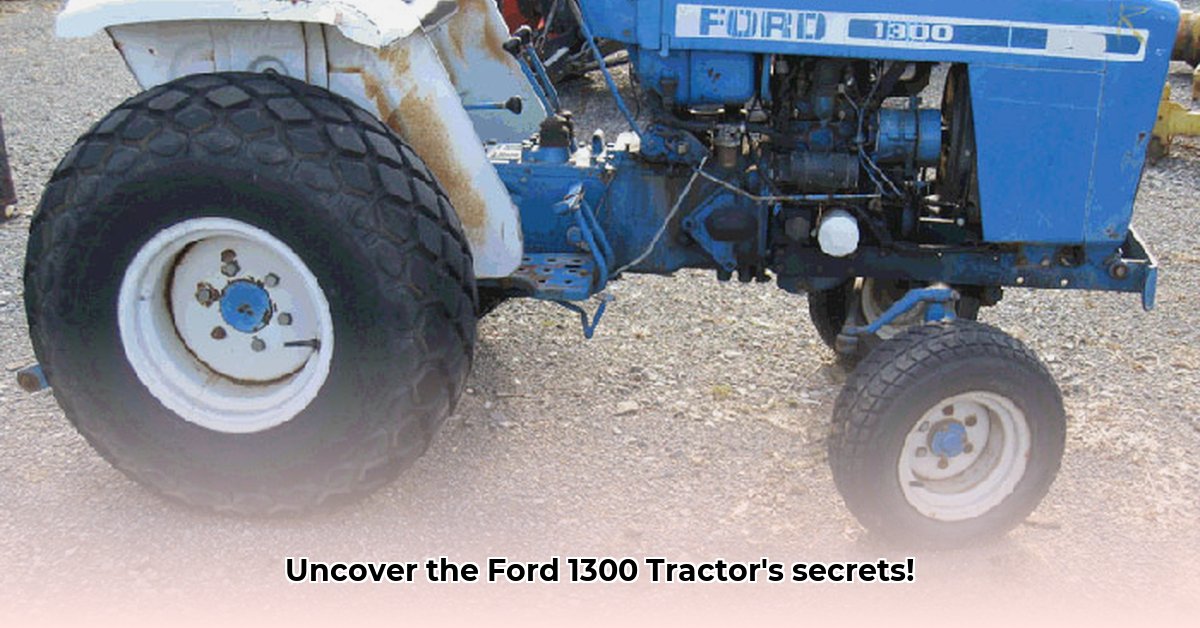
The Ford 1300 tractor, a compact powerhouse produced from 1979 to 1983, represents a fascinating chapter in agricultural history. This article delves into its origins, technical specifications, capabilities, limitations, and ongoing relevance, providing a comprehensive guide for enthusiasts, collectors, and prospective owners. We'll explore its unique design philosophy, maintenance strategies, and even touch upon potential restoration projects. Whether you're a seasoned farmer or a vintage machinery aficionado, get ready to discover the enduring appeal of this remarkable workhorse. For more information on other Ford tractors, check out Ford tractor specs.
A Legacy Forged in Compact Power: History and Background
The Ford 1300, though bearing the Ford name, was actually manufactured by Shibaura (later Kubota) – a testament to the collaborative spirit of agricultural technology in the late 70s and early 80s. Its design philosophy centered on compact size and versatility, targeting smaller farms, orchards, and specialized tasks where maneuverability trumped sheer power. Unlike its larger counterparts, designed for expansive fields, the 1300 was conceived as a nimble, adaptable machine for diverse applications. This focus on versatility is reflected in its ability to accept a wide array of attachments, transforming it from a cultivator to a snow blower with relative ease. This adaptable nature solidified its place as a crucial tool for farmers needing a compact powerhouse.
Unveiling the Mechanics: Technical Specifications
At the heart of the Ford 1300 lies a robust Shibaura LEK802D diesel engine, delivering approximately 13.5-16 horsepower (depending on PTO vs. gross horsepower). While seemingly modest by modern standards, this power output proved surprisingly effective considering the tractor's compact size and targeted applications. The compact design, boasting a wheelbase of just 56.7 inches and weighing between 1773 and 2139 lbs (depending on configuration), contributed significantly to its renowned maneuverability. Its transmission, typically featuring 12 forward and 4 reverse gears, provided the operator with precise control in varied conditions. The hydraulic system, while simpler than its modern counterparts, was perfectly adequate for its intended purpose – supplementing diverse attachments and adding to the tractor's versatility.
Isn't it remarkable how this seemingly simple machine could handle such a variety of agricultural tasks? This adaptability, a hallmark of the 1300, allowed it to cater to a wide spectrum of farming needs.
Capabilities and Limitations: A Realistic Assessment
The Ford 1300 truly excels in confined spaces. Orchard maintenance, small-scale farming, and light-duty tasks were tailor-made for its capabilities. Its compact size and agility provided unrivaled maneuverability in tight spaces, making it a favorite amongst farmers with limited acreage or those working in crowded environments. However, it's crucial to acknowledge its limitations. The absence of power steering presented a significant physical demand on the operator, especially during prolonged use. Furthermore, its simpler, more mechanical design falls short of the sophisticated electronics and automated systems present in contemporary tractors. It's not designed for heavy-duty plowing or expansive fields – its strength lies in its versatility and efficiency within its specific niche.
Maintaining Your Legacy: Maintenance and Restoration
Preserving a Ford 1300 necessitates a proactive approach to maintenance. Regular oil changes (using the manufacturer's recommended viscosity), consistent checks of transmission fluid levels, and thorough lubrication of moving parts are non-negotiable. Careful inspection of hydraulic lines and hoses for leaks is also crucial to prevent more significant issues. Seasonal storage, shielding it from harsh elements, significantly contributes to its longevity. Remember, preventative maintenance is key to extending the life of this hardworking machine.
"Regular maintenance is the cornerstone of keeping your Ford 1300 in prime condition," states John Miller, a seasoned mechanic specializing in vintage farm equipment.
A Practical Maintenance Checklist:
- Oil Changes: Adhere strictly to the manufacturer's recommended oil change intervals.
- Fluid Levels: Regularly monitor transmission and hydraulic fluid levels and top them off as needed.
- Lubrication: Grease and lubricate all moving parts using the correct lubricants specified in the owner's manual.
- Hydraulic System Inspection: Regularly inspect hydraulic lines and hoses for any signs of leaks, cracks, or damage, replacing any faulty components promptly.
- Seasonal Storage: Store the tractor indoors during the off-season, protecting it from the elements and ensuring longevity.
Finding replacement parts can be challenging for a vintage tractor such as the Ford 1300. However, online forums and online communities dedicated to vintage Ford tractors can often provide invaluable sources for parts, guidance, and support.
Enduring Relevance: The Ford 1300 in the Modern Era
Despite the advancements in agricultural technology, the Ford 1300 retains relevance today. Its simplicity appeals to vintage machinery enthusiasts who appreciate the robust mechanical nature and the unique satisfaction of working with less technologically advanced equipment. Small-scale farmers and proponents of sustainable agriculture may find it perfectly suited to their needs, especially for tasks requiring precision and maneuverability within limited spaces. Furthermore, the tractor has accumulated a dedicated collector base, with restored models commanding increasing value in the vintage machinery market. The Ford 1300, therefore, retains its appeal not only as a functional piece of equipment but also as a tangible link to a rich agricultural past.
Did you know that the Ford 1300’s compact size is proving increasingly popular among urban farmers and those practicing sustainable agriculture? This speaks to its enduring relevance in a constantly evolving agricultural landscape.
Conclusion: A Timeless Legacy
The Ford 1300 tractor stands as a testament to robust engineering and adaptable design. Its compact size, versatility, and relatively straightforward mechanics make it a desirable machine for a variety of applications, even in the modern era. While it possesses limitations compared to modern tractors, its enduring appeal stems from its ability to efficiently handle specific tasks in a unique and rewarding way. Whether appreciated for its historical significance, its practical utility, or its potential for restoration projects, the Ford 1300 continues to capture the hearts and minds of enthusiasts worldwide. By understanding its history, capabilities, and maintenance requirements, one can fully appreciate this timeless piece of agricultural heritage.